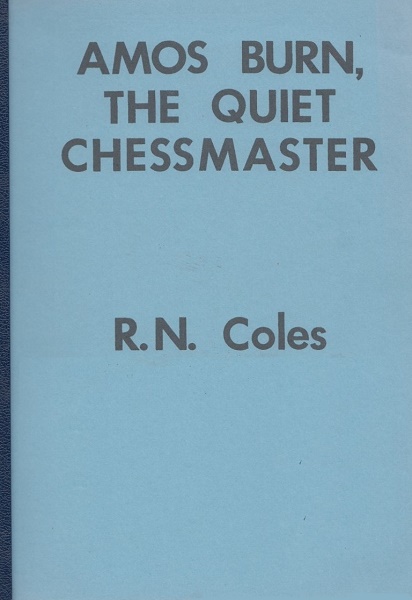
Edward Winter
Richard Nevil Coles died on 2 April this year [1982]. A subscriber to this magazine and our colleague in the production of World Chess Champions, he will be remembered as one of this century’s most outstanding chess historians. The culmination of his painstaking work was, we would suggest, his re-habilitation of Howard Staunton. This was achieved not only through the publication with Raymond Keene of Howard Staunton, the English World Chess Champion (BCM, 1974) but, less conspicuously, through many carefully researched articles in the BCM over many decades. By the time World Chess Champions came to be written, it would have been unthinkable to enlist the services of anyone other than R.N. Coles for the Staunton chapter. Amongst all the other books by R.N.C. we would single out one that has always struck us as truly exceptional: Dynamic Chess. For an explanation of the history of chess ideas, schools and strategies it is unlikely ever to be bettered.
(119)
Earlier this year [1983] W.H. Cozens brought to our attention the fact that a manuscript prepared by the late R.N. Coles – a games collection of Amos Burn – remained unpublished still; nobody could be found to bring out an edition. This, of course, is a reflection of the times, since many worthy projects fail to come to fruition now because publishers cannot afford to take the risk of doing small, sometimes slow-selling, limited editions. Even so, it came as a shock to learn that the BCM board turned down the idea of printing the Coles work as a ‘Quarterly’. Thanks to the kindness of Mr Graham Smith of Guildford, England, the Burn manuscript is now in our hands, and we plan to publish it ourselves. Entitled Amos Burn, The Quiet Chessmaster, it is a truly exceptional work comprising a detailed biography, full tournament record and 62 finely annotated games into which R.N.C. has clearly put a colossal amount of work
(549)

Two decades later, the Coles book was Richard Forster’s inspiration for producing one of the largest chess biographies ever written, as noted in C.N. 3403:
If there is one chess book, among all others, that we would be immensely proud to have written ourselves it is Amos Burn A Chess Biography by Richard Forster (Jefferson, 2004). An impeccable McFarland hardback of 972 pages, it is simply of matchless quality.
(3403)
The publisher subsequently brought out a paperback edition in two volumes.
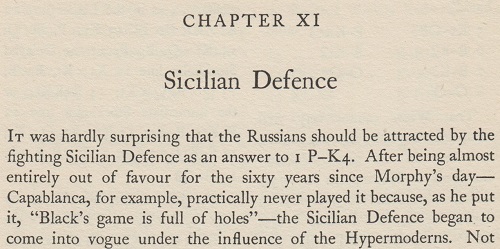
We are still trying to find out on what grounds R.N. Coles wrote on page 137 of Dynamic Chess (London, 1956) that Capablanca gave as his reason for practically never playing the Sicilian Defence, ‘Black’s game is full of holes’ (C.N. 2105). The passage is on page 135 of the Dover edition (New York, 1966).
(3961)
‘No world championship match ever produced a finer struggle than this.’
So wrote R.N. Coles on page 119 of Battles-Royal of the Chessboard (London, 1948), with regard to the 11th game of the 1929 Alekhine v Bogoljubow match. (He placed the game, a 63-move draw, in Wiesbaden instead of Heidelberg.)
Bogoljubow’s annotations were published on pages 408-410 of the December 1929 Kagans Neueste Schachnachrichten.
From page 170 of the November 1929 American Chess Bulletin:
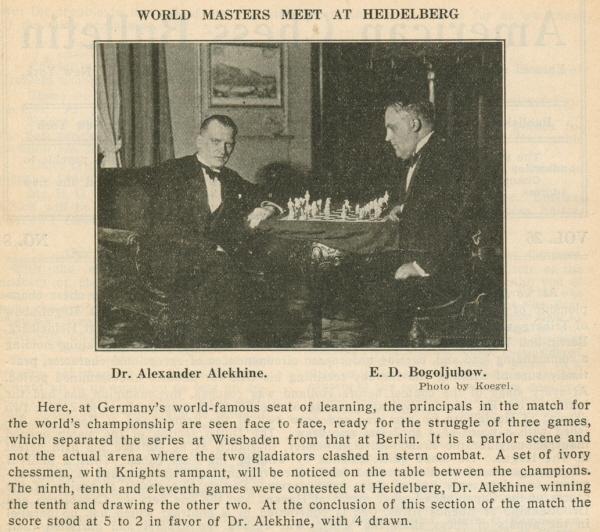
(6692)
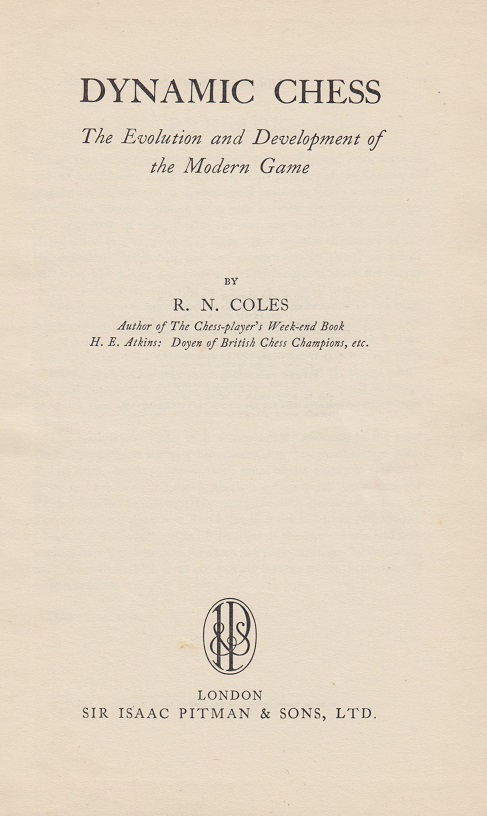
The sections on Nimzowitsch in R.N. Coles’ highly-regarded book Dynamic Chess (London, 1956) may be read in conjunction with two articles contributed by Coles to Chess Review that year: ‘New Light on Nimzovich’ (April, pages 108-109) and ‘The Negative Dynamism of Nimzovich’ (November, page 334).
The former article began:
‘That strange genius, Aron Nimzovich, was a chessmaster of many parts, but in no way was his genius more strikingly illustrated than in his ability to convince the world that Aron Nimzovich was a genius and a true original.
Closer examination reveals that Nimzovich’s claims cannot always be substantiated, as for example in his claim to be the discoverer of the theory of over-protection. “That strategically important points”, he writes in his Chess Praxis, “should be over-protected is a principle discovered by the author.” My answer to that is, “Nonsense!”’
Coles subsequently wrote:
‘... all that Nimzovich really did was to invent the phrase, “over-protection”, and for so doing he won all the credit (plus a good deal of adverse criticism) for the idea of over-protection.
In point of fact, he was merely filching an idea from Steinitz, dressing it up as his own and presenting it as part of MY System.’
Coles then gave Steinitz v Weiss, Vienna, 1882, with notes from Dynamic Chess, to demonstrate that Steinitz ‘knew all about over-protection nearly half a century before Nimzovich launched it on the world as his own’.
He concluded:
‘I am not denying Nimzovich his great ability as a player, nor that he was an original thinker, but merely pricking that bubble of bluff which he also handled like a master of another kind ...
I hope that Dynamic Chess will prove illuminating, not merely as putting a few of the Hypermodern ideas in their proper context but also as a review of the Dynamic style of which Nimzovich was genuinely one of the founders, though in some respects to a lesser extent than he himself would have had us believe.’
An editorial footnote quoted a letter from Coles:
‘The article [above] is more polemical than the book [is] on the same subject, since I did not feel that the book was the place to start up hares (or red herrings) of this nature. ... I feel that, if Nimzovich is to be debunked in some small degree, an article rather than a general treatise is the place for it.’ (Ellipses and additions in square brackets are as in the original.)
Concerning over-protection (Überdeckung), we seek early sightings of the term. From page 159 of the September 1901 Wiener Schachzeitung:

The problem was on page 161:

The composition had also been published on page 139 of the July 1901 Wiener Schachzeitung. The solution was on page 22 of the January 1902 issue.
Below is Wolfgang Heidenfeld’s entry on over-protection on page 230 of The Encyclopedia of Chess by Harry Golombek (London, 1977):
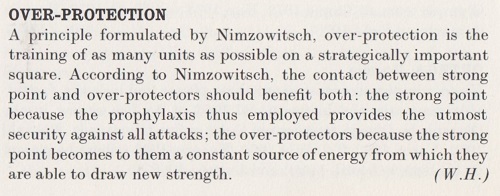
We add without comment what Nathan Divinsky gave on page 154 of The Batsford Chess Encyclopedia (London, 1990):
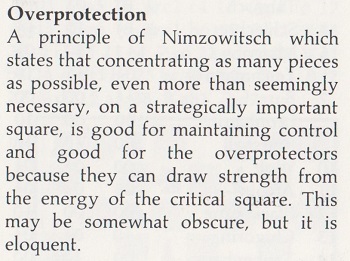
A third-person summary of the above-mentioned Steinitz v Weiss game was published by Steinitz in his Field column of 3 June 1882, page 753:
‘Steinitz treated the French defence, adopted by Weiss, in the same fashion as against Fleissig, viz with the new move 2 P to K5, to which Weiss replied 2...P to QB4. Steinitz then proceeded with P to KB4 and the K fianchetto. He carefully abstained from all attempts at exchanging his QP against the QBP, but kept the QP at Q3. He, however, exchanged immediately, in passing, his KP for the adverse QP as soon as the latter advanced, and he thus obtained the open K file, which, according to his idea, should be the main object of the attack. White had a good game throughout; and, after having well secured the Q side, he opened an attack on the K side, which forced the gain of a P and brought the adverse K into serious trouble. Steinitz wound up with an interesting sacrifice of the exchange, which forced a mate after four hours’ play.’
The second Chess Review article by R.N. Coles in 1956 (November issue, page 334), ‘The Negative Dynamism of Nimzovich’, stated:
‘Nimzovich, instead of seeking at all costs to increase the dynamic potentialities of his own position, played instead to reduce at all costs the dynamic potentialities of his opponent’s position.’
After a discussion of certain openings favoured by Nimzowitsch, there came this key section:
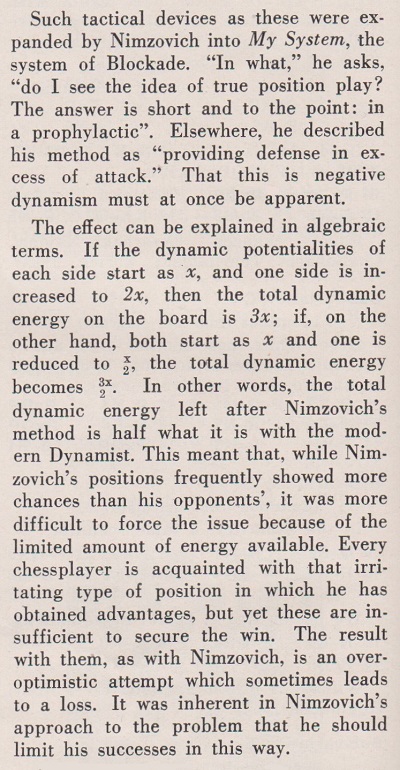
Under the title ‘The Evolution of Chess Method’ R.N. Coles also discussed Dynamic Chess, although not Nimzowitsch, on page 317 of CHESS, 8 September 1956, following a book review on page 246 of the 26 May issue and a letter from a reader, J. Taylor, on page 278 of CHESS, 7 July.
(10453)
Some games played by the chess historian and theoretician R.N. Coles (1907-82):
Richard Nevil Coles – M. Benger
Surrey Championship, 1936
Ruy López
1 e4 e5 2 Nf3 Nc6 3 Bb5 a6 4 Ba4 d6 5 Bxc6+ bxc6 6 d4 f6 7 Be3 g6 8 Qd2 Bg7 9 h3 Ne7 10 Nc3 Be6 11 dxe5 fxe5 12 Ng5 Bg8 13 O-O d5 14 Bc5 d4 15 Ne2 Nc8
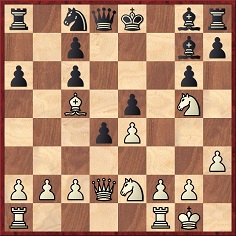
16 f4 Bh6 17 fxe5 Bc4 18 h4 Bxg5 19 hxg5 Bxe2 20 Qxe2 Qxg5 21 Rad1 Qe3+ 22 Qxe3 dxe3 23 Bxe3 Nb6 24 Bxb6 cxb6 25 Rd6 Rf8 26 Rff6 Rxf6 27 exf6 Rc8 28 e5 Kf7 29 Rd7+ Ke6 30 Re7+ Kf5 31 g4+ Kg5 32 f7 Rf8 33 e6 Kf6 34 Re8 Kg7 35 g5 Resigns.
Source: BCM, February 1942, page 42. ‘Another peace-time game of a reader sent by White.’
Gilbert V. Butler – Richard Nevil Coles
Battersea v Kingston match (date?)
Alekhine’s Defence
1 e4 Nf6 2 Nc3 d5 3 exd5 Nxd5 4 d4 Nxc3 5 bxc3 g6 6 Bd3 Bg7 7 Ne2 O-O 8 O-O c5 9 Be3 Bg4 10 f3 cxd4 11 cxd4 Be6 12 Rb1 Nc6 13 Rxb7 Nxd4 14 Be4 Nxe2+ 15 Qxe2 Bxa2
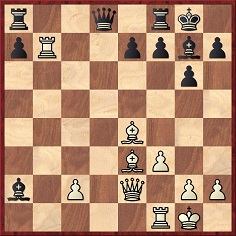
16 Rd1 Bc4 17 Qe1 Bc3 18 Rxd8 Bxe1 19 Rxa8 Rxa8 20 Rb1 Resigns.
Source: BCM, January 1943, page 12. This game was in the obituary of G.V. Butler.
G.H. Barrett – Richard Nevil Coles
Correspondence game, 1945
English Opening
1 c4 e5 2 Nc3 Nf6 3 Nf3 Nc6 4 d4 exd4 5 Nxd4 Bb4 6 Bg5 h6 7 Bh4 g5 8 Bg3 d6 9 e3 Qe7 10 Nxc6 bxc6 11 Qb3 Bxc3+ 12 Qxc3 Bf5 13 c5 Kd7 14 cxd6 cxd6 15 Rc1 Rhc8 16 Ba6 Rc7 17 O-O Ne4 18 Qa5 Bg6 19 Rfd1 f6 20 Rc4 Nxg3 21 hxg3 Rb8
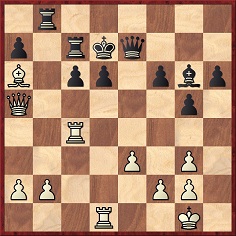
22 Rxd6+ Qxd6 23 Rd4 Qxd4 24 exd4 Rxb2 25 Qa3 Rb1+ 26 Kh2 Rb8 27 Qc5 Be4 28 Bc4 Rcb7 29 f3
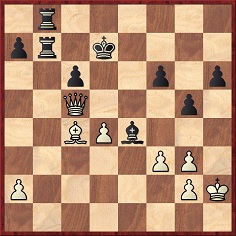
29...Bd5 30 Bxd5 cxd5 31 Qxd5+ Ke7 32 Qe4+ Kf7 33 Qh7+ Ke6 34 Qxh6 Rd7 35 Qh3+ Ke7 36 Qf5 Rbd8 37 g4 Rxd4 38 Qc5+ Kf7 39 Qxa7+ R4d7 40 Qb6 Ra8 41 f4 gxf4 42 Qb4 Rda7 43 Qxf4 Kg7 44 g5 fxg5 45 Qxg5+ Kh8 Drawn.
Source: BCM, September 1945, pages 222-223. The game, between ‘P/O. G.H. Barrett’ and ‘Lt R.N. Coles’, had the latter’s notes. It was ‘played in a BCCA Forces tourney, January to June 1945’.
Richard Nevil Coles – E.W. Driver
Correspondence game
Giuoco Piano (Møller Attack)
1 e4 e5 2 Nf3 Nc6 3 Bc4 Bc5 4 c3 Nf6 5 d4 exd4 6 cxd4 Bb4+ 7 Nc3 Nxe4 8 O-O Bxc3 9 d5 Bf6 10 Re1 Ne7 11 Rxe4 d6 12 Bg5 Bxg5 13 Nxg5 O-O 14 Nxh7 Kxh7 15 Qh5+ Kg8 16 Rh4 f5 17 Re1 Ng6 18 Rh3 Rf6 19 Rg3 Kf7 20 Bb5 Bd7 21 Bxd7 Qxd7
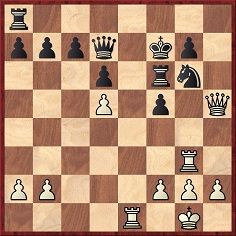
22 Rxg6 Rxg6 23 Re6 Qxe6 24 dxe6+ Kf6 25 Qf3 Rd8 26 Qxb7 Kxe6 27 Qxc7 Rd7 28 Qc4+ d5 29 Qc6+ Rd6 30 Qe8+ Kf6 31 f4 d4 32 Kf2 d3
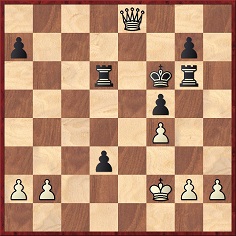
33 g4 fxg4 34 Qf8+ Ke6 35 f5+ Kd7 36 fxg6 d2 37 Qxd6+ Kxd6 38 Ke2 Kd5 39 Kxd2 Kd4 40 Ke2 Ke4 41 Kf2 Kf4 42 b4 g3+ 43 hxg3+ Ke4 44 b5 Resigns.
Source: BCM, June 1947, page 193. The game was from ‘last season’s Major Tournament’.
Richard Nevil Coles – Vernon Dilworth
Correspondence game, 1947
Giuoco Piano
1 e4 e5 2 Nf3 Nc6 3 Bc4 Bc5 4 c3 Qe7 5 O-O Nf6 6 b4 Bb6 7 a4 a6 8 d4 d6 9 a5 Ba7 10 b5 axb5 11 Bxb5 O-O 12 Bxc6 bxc6 13 Ba3 Nd7 14 Nbd2 Ba6 15 Re1 Qf6 16 Nf1 Rfe8 17 Ng3 Rab8 18 Bc1 h6 19 Be3 exd4 20 Bxd4 Bxd4 21 cxd4 d5 22 exd5 Rxe1+ 23 Qxe1 cxd5 24 Qc1 c6 25 h3 Rb5 26 Qe3 Nc5 27 Qe8+ Kh7 28 Ne5 Nb3 29 Nh5 Qg5
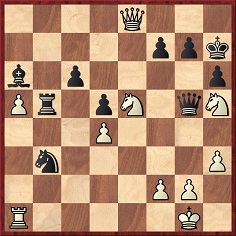
30 Nxf7 Qxh5 31 Qh8+ Kg6 32 Ne5+ Kf6 33 g4 Rb7 34 Qd8+ Ke6 35 Qc8+ Ke7 36 Re1 Resigns.
Source: BCM, March 1948, page 83. The game was in the column of the British Correspondence Chess Association with the heading ‘played in the Premier Tournament, 1947’.
R.N. Coles sent us the following autobiographical note in a letter dated 4 April 1979:
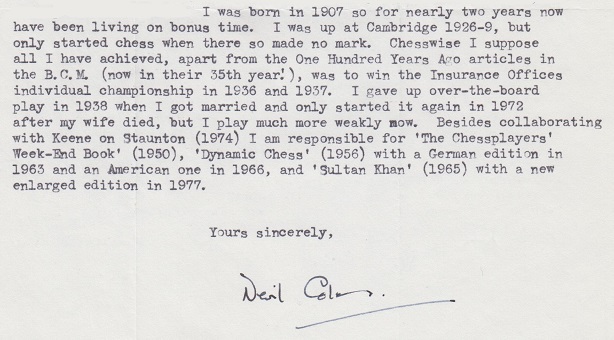
(10455)
Here we add a biographical note by his brother Jack which was forwarded by Graham Smith (Guildford, England) on 28 September 1983:
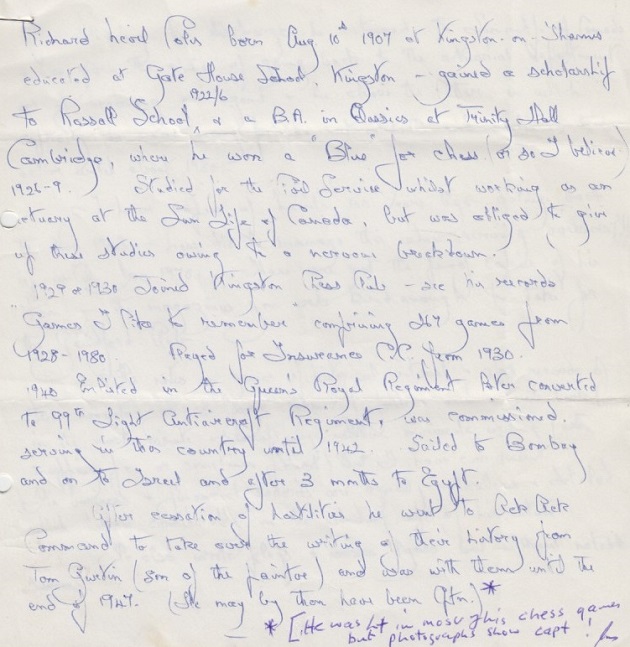
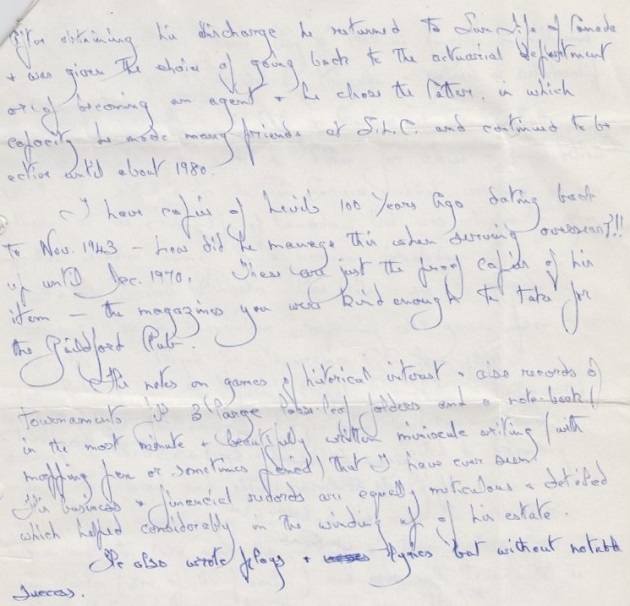
(11818)
Addition on 3 June 2025:
G.H. Diggle wrote the text below in the June 1982 Newsflash. It was reproduced on page 82 of Chess Characters (Geneva, 1984):
‘The sudden death of R.N. Coles has deprived us of one of the greatest and most versatile British chess authors and historians of this century. He was a profound and tireless researcher who would never accept “hearsay evidence” and who knew where to look for his material. His knowledge of the contents of nineteenth-century chess columns such as the ILN and Bell’s Life was unique. In one of his best works – Battles-Royal of the Chessboard – he unearthed 50 great games, most of which but for him would have been now forgotten. He was equally at home when dealing with such wide-ranging period personalities as Sultan Khan and Howard Staunton. Perhaps his greatest service to chess was the restoration of the latter (after nearly a century of gross neglect) to his rightful place in the chess hierarchy. Bobby Fischer indeed “lent a vital hand” when he included Staunton in his famous “top ten”. But Coles was the real pioneer. Month by month in the BCM of the ’40s he produced his vivid “Hundred Years Ago” lantern slides depicting the great man and his contemporaries and exhuming their long-forgotten games. Previously for whole decades it had been assumed that there was no chess worth playing through between the death of Labourdonnais and the rise of Anderssen. Writers who should have known better relied on Morphy’s juvenile joke about “devilish bad games” and looked no further. Réti, Euwe and Lasker in their great works on the development of chess strategy all ignored Staunton entirely and heaped mountains of gold, frankincense and myrrh on Steinitz as the Messiah. Even Murray called Staunton deficient in imagination and “content to keep to the well-trodden paths”. But this, as Coles and Keene convincingly showed in Howard Staunton, the English World Chess Champion, was just what he didn’t do – for instance, he popularized fianchettoed bishops, previously laughed out of court by Labourdonnais, who nicknamed them “the little chapels”. After Howard Staunton came out in 1975, Coles wrote to the BM: “I am so glad you enjoyed the book. I certainly felt it was worth writing and so did Ray Keene. Indeed we were so much in agreement in our view on Staunton that some of his essay-type game notes became paragraphs in the biography.”
It is curious that the two English writers who have paid Staunton the most attention were Presidents of the Guildford Chess Club (though with an interval of 30 years between them) – P.W. Sergeant (died 1952) and R.N. Coles, of whom the Club (and indeed the chess world) have just been sadly deprived. Both achieved sterling work on Staunton, though each viewed him very differently. “P.W.S.” scrupulously struggled to be fair to him, but it was “R.N.C.’s” imaginative sympathy that really brought the great English player to life.’
See too Sultan Khan.
To the Archives
for other feature articles.
Copyright Edward Winter. All rights reserved.